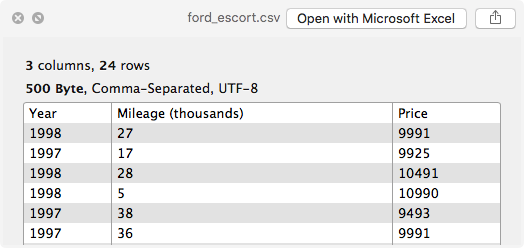Previewing CSV files on macOS
The comma-separated values (CSV) file format is often used to store and share tabular data. A CSV file is simply plain text, which makes it easy to share across applications and platforms.
Microsoft Excel and Apple’s Numbers can open these files as a spreadsheet. However, there are times when all you need is a quick and simple read-only option.
macOS – Quick Look

Quick Look on a CSV file using quicklook-csv
One handy feature of macOS is Quick Look. Any file can be previewed by pressing space, instead of opening through an application. Custom Quick Look plugins can be installed to work with certain file types. For CSV and other plain-text delimited files, there is quicklook-csv by Pascal Pfiffner.
The downside of this option is that it takes time to preview larger files. This is when the command line approach is desirable.
Command Line
If the file is small, the column command is sufficient to show contents in a pretty tabular format.
$ column -t -s , ford_escort.csv
"Year" "Mileage (thousands)" "Price"
1998 27 9991
1997 17 9925
1998 28 10491
1998 5 10990
1997 38 9493
...
Additionally, other commands can be used to customize the view.
head– get a few rows from the file.cut– get a subset of the columns. Useful if one column contains long entries that would overflow the screen.less– view the output in a pager rather than the default output stream. Useful if the file has many lines.
Pipes can be used to combine the commands. For example,
head -n 100 example.csv | cut -d , -f 2-6 | column -t -s , | less -S
displays a pager for the first 100 rows of example.csv with just columns 2-6. The -S option for less prevents line wrapping for a better view.
References
- example CSV file: ford_escort.csv
- in-depth post on command line CSV viewing: http://stefaanlippens.net/pretty-csv.html